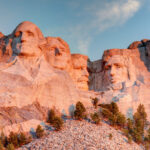
1. TAPA CENTRAL TRAINING AREA, Estonia – Estonian CV90 Infantry fighting vehicles hold their position in the woods here, May 9, 2021, as U.S. Army and Estonian Defense Force Soldiers of Bravo Company, Scouts Battalion prepare to train together for follow-on missions. This training is a part of Swift Response 21, a linked exercise of DEFENDER-Europe 21. DEFENDER-Europe 21 is a large-scale U.S. Army-led exercise designed to build readiness and interoperability between the U.S., NATO allies and partner militaries. This year, more than 28,000 multinational forces from 26 nations will conduct nearly simultaneous operations across more than 30 training areas in more than a dozen countries from the Baltics to the strategically important Balkans and Black Sea Region. Follow the latest news and information about DEFENDER-Europe 21, visit www.EuropeAfrica.army.mil/DefenderEurope. (U.S. Army photo by 1st Lt. Ian Fischer)
Despite its losses in Ukraine, Russia’s military still has teeth. Robbie Gramer and Jack Detsch report in Foreign Policy:
TAPA, Estonia—The AMX-10 RC tank destroyer has been deployed to far-flung battlefields in Afghanistan and counterterrorism operations in Mali. Now, they’re being deployed as part of a French combined arms squadron to Estonia, near the Russian border, to train with NATO forces and flex the Western alliance’s muscles against neighboring Russia.
For decades, Russia amassed the bulk of its advanced military forces in the so-called Western Military District, hunkered down on NATO’s borders, including near the Baltic States. Now, many of those forces have been thrown into the meat grinder in Ukraine, where Russia’s army has suffered devastating losses that could take decades to rebuild.
But even as the war drags on in Ukraine, Russia plans to rebuild its forces facing its new and expanded frontiers with NATO, according to interviews with multiple Eastern European defense and military officials. Officials in Washington may be sanguine about the longer-term threat from a Russia that has sowed Ukrainian fields with conscript bodies, but in Eastern Europe, and especially the Baltics, things still look dicey. Russia could fully reconstitute the number of troops facing the Baltic countries in a matter of two months to two years, these officials said, posing a new threat of a Russia-NATO military showdown even if the conflict in Ukraine isn’t resolved.
Even if the troops and equipment won’t be of the same quality as those deployed to the region before the war, defense officials say they would be sizable enough to carry out an incursion into NATO territory—making units like the French combined arms squadron all the more significant for their deterrence value.
“Russia has plans to increase considerably the number of forces behind the Estonian and Latvian borders,” said Tuuli Duneton, undersecretary for defense policy at the Estonian Ministry of Defense. “According to our assessments, Russia is going to be able to reconstitute its forces in two years,” with the potential to launch a limited incursion against NATO, she said.
For now, the Russian forces facing NATO’s vulnerable northeastern flank represent a skeleton crew of what was once there. Russia’s hopes for a quick victory in Ukraine were dashed thanks to military incompetence and effective Ukrainian resistance, forcing Moscow to rush troops from areas far north of Ukraine into the battlefield. But Russia’s ability to mobilize fresh troops, even poorly trained conscripts and reservists with aged equipment, showcases a capability that has alarmed military planners in Europe.
Read more here.
If you’re willing to fight for Main Street America, click here to sign up for the Richardcyoung.com free weekly email.




